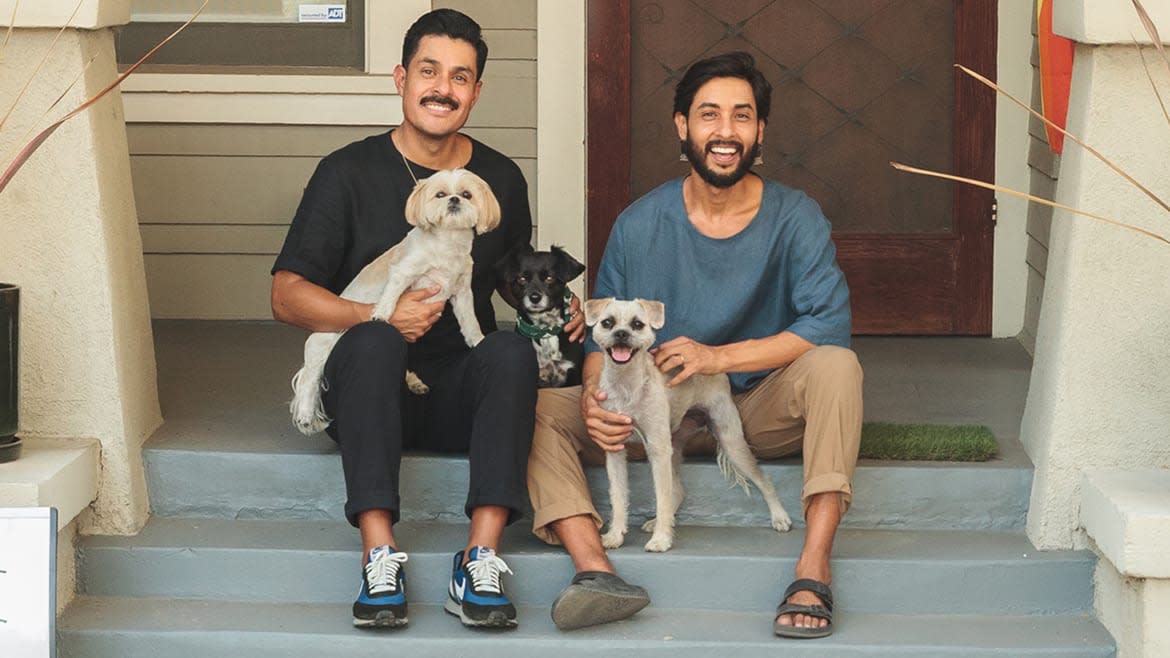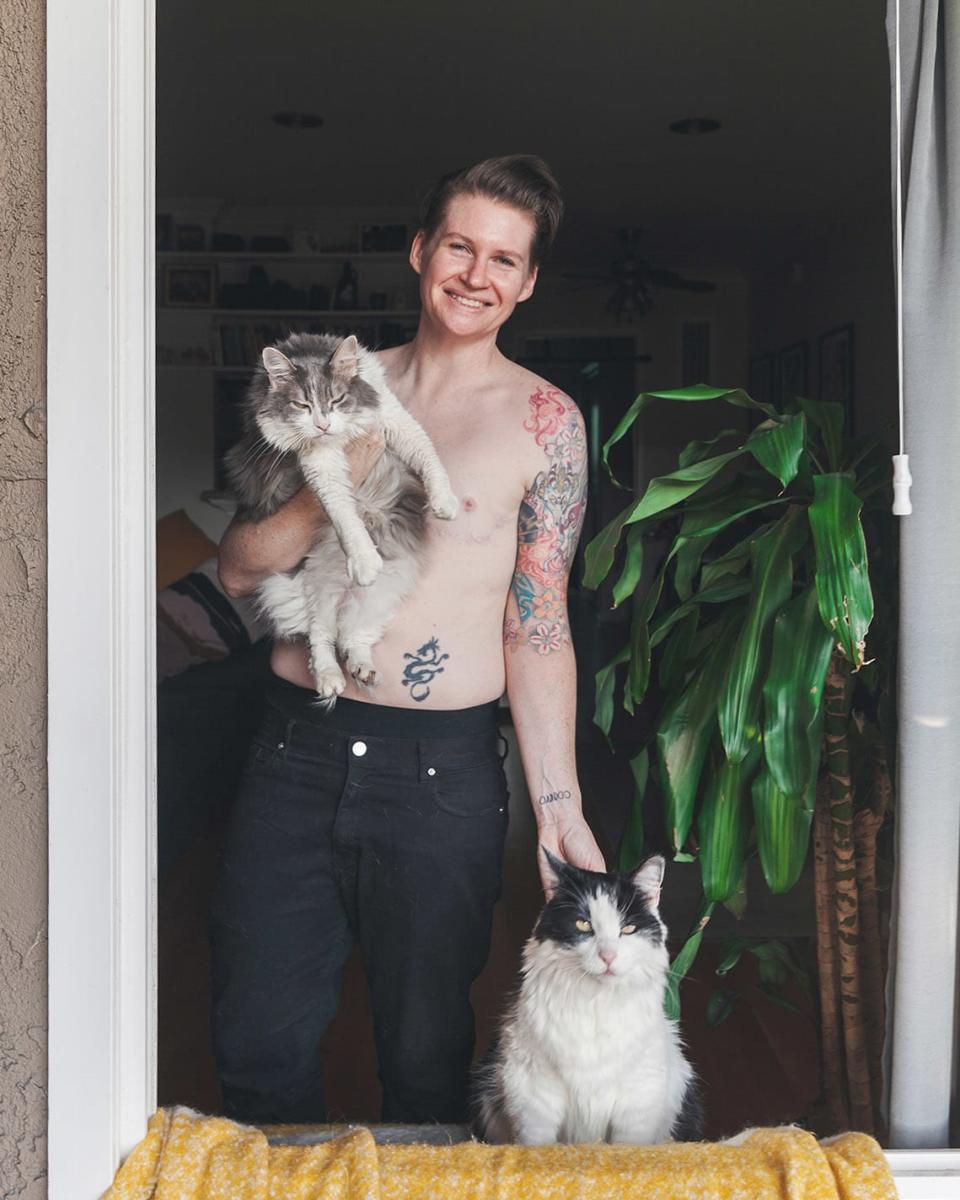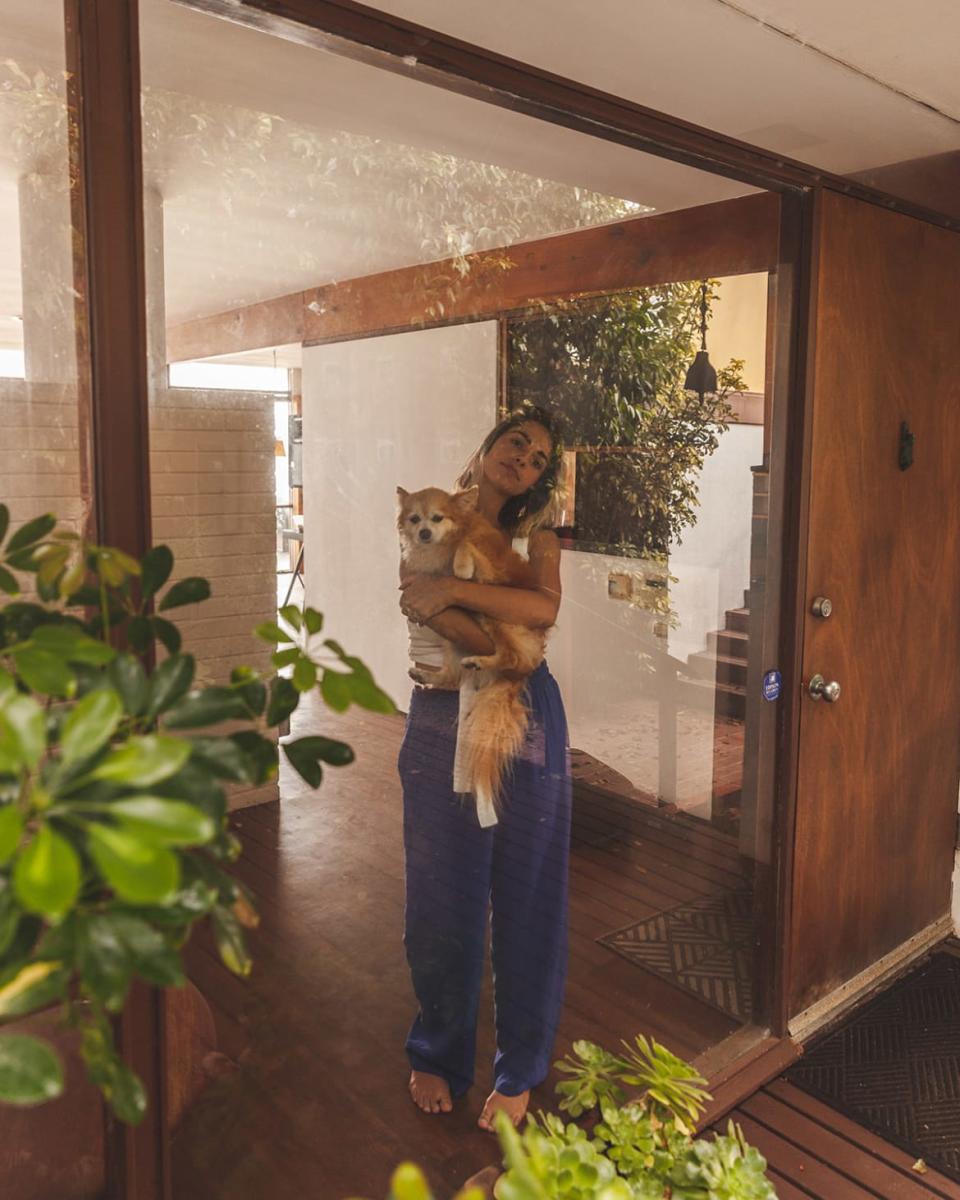How Pets Helped These LGBTQ Families Survive the Pandemic

- Oops!Something went wrong.Please try again later.
It was nearly a year ago, but Fernando and Carlos Estrada-Lopez remember that hot summer day vividly.
They were wrangling their three dogs, Montse, Teo, and Flan, together for a family portrait and, surprisingly, all three dogs were happily cooperating. They were intrigued by the camera equipment that filled their yard that afternoon after a long spell in isolation. And that day, the curiosity, happiness and love the Estrada-Lopez family has for their dogs was forever captured in a photograph taken by the Los Angeles-based, Canadian-born photographer Sorrell Scrutton.
Pet Adoption Is Way Up. But What Happens When Quarantine Ends?
Like many people at the beginning of the pandemic, Scrutton was at a loss at what to do. Having previously specialized in portrait and pet photography, Scrutton found themself having to close down their photo studio, since seeing people in person, let alone inside, was not an option at the time.
“While I was sort of trying to figure out what to do and panicking like the rest of the world, I wasn’t really taking photos or anything,“ said Scrutton. “It was kind of like a low point because I love what I do.”
Then, thanks to social media, inspiration stuck. Seeing so many people get creative online during the pandemic reminded Scrutton of a project they had wanted to do for a long time, but which had fallen to the back burner: photographing queer families at their homes with their pets.
Scrutton decided, since people can’t go to a studio, they would go to the people. With this idea, The Queerantine Project was born.
“To me there’s something powerful about sitting in front of your home, whatever, wherever that is,” said Scrutton.
When the project began in August 2020, Scrutton had the goal of taking 100 portraits. Now, they have taken nearly 150 portraits and are still going strong. They have even branched out beyond Los Angeles into San Diego, Joshua Tree, Palm Springs, and the Bay Area.
“It just came to me [as] a way to be creative for one [and to] work, keep shooting [and] keep taking photos,” said Scrutton, who identifies as non-binary and queer. “Really, it kept me kind of alive.“
The project began with Scrutton reaching out to queer friends in Los Angeles with pets to ask if they’d like a portrait with their family.
“When Sorrell was putting the project together they wrote asking if we were interested in a photo and I’m always, always down for a photo, especially when the world is ending,” said Sabrina Jalees, who knew Scrutton from Toronto.
Jalees can’t remember the exact day Scrutton came over to take the portrait of their family, which included their wife Shauna McCann, son Wolfie McLees, and dog Cowboy McLees, but she remembers it being early enough in the pandemic that having Scrutton over, even outside, to take photographs was “controversial.”
“It was like a shot of vodka during prohibition,” Jalees said.
After the photoshoot was done, Jalees had Scrutton stick around for a socially distanced dinner. “We were just like, ‘We don’t want this to end, a new person has come,’” Jalees said.
For all the people they photographed, Scrutton made sure to follow rigorous safety protocols while shooting the photos. Scrutton would stay in the yard or driveway, farther than six feet away, and came prepared with gloves, sanitizer and, of course, a face mask.
When Scrutton started posting these portraits of their friends to Instagram under the handle queerantine_project, the project suddenly became much bigger and more popular.
“It really grew and just sort of became its own life force,” said Scrutton. “After the first 10 images that I posted, I was just getting tons of people messaging me. I couldn’t keep up with the DMs.”
“Our dogs are our children. That they were included as part of that family structure felt right and loving.”
In the beginning, Scrutton responded to DMs directly on Instagram to set up photoshoots. However, it soon became overwhelming and they decided to start a booking system. Prior to that, the entire project was on a pay-what-you-can basis, but as it grew and more people reached out, Scrutton started asking $50 to cover their gas and equipment costs.
In the summer of 2020 as Black Lives Matter protests erupted around the world in response to the killings of George Floyd and Breonna Taylor, Scrutton decided to donate some of the proceeds from the photoshoots to queer and trans people of color, even though Scrutton was struggling at times to make rent.
“I just felt like, yes, I have no money and I’m not working and I’m stressed about the future and what am I going to do?” said Scrutton. “But I still felt like I was in a place of privilege that I could use my skills to help people.”
Scrutton says they have so far donated over $2,000 to people in need. All the Gofundme’s they donated to can be found on the Queerantine Instagram page.
Photography projects documenting queer lives in domestic settings are not new. Jamal Jordan’s Queer Love in Color, celebrating the lives and relationships of queer people of color, was recently published to much acclaim. Loving: A Photographic History of Men in Love 1850s-1950s was published last year. JEB’s (Joan E. Biren) Eye to Eye: Portraits of Lesbians was reprinted last year, 40 years after it was first published. The documentary Reel in the Closet fascinatingly documented LGBTQ home videos from the 1940s to Stonewall.
In 2013, Gerard H. Gaskin’s photographs from the house ballroom scene in New York, Washington, D.C, and a few other cities were published in Legendary: Inside The House Ballroom Scene. Currently, the global project “Where Love Is Illegal,” led by photographer Robin Hammond and the non-profit Witness Change, takes portraits of LGBTQ people living in countries where being LGBTQ is illegal.
Scrutton’s project focuses on the importance of pets in queer families.
“So many queer partnerships have pets as sort of the care-taking aspect of it, and that to us was really special,” said Fernando Estrada-Lopez, who is gay. “Our dogs are our children. That they were included as part of that family structure just felt right and loving. It felt warm. It felt affirming.”
It is not just traditional pets like dogs and cats that are included in the project, but also rats, turtles, and even plants.
“It’s another sector of self care, being responsible for another life,” said Scrutton. “It helps you get out of bed in the morning. To me, it was just a really obvious thing that I needed to show. And it’s also very wholesome.”
Scrutton also had their own personal reasons for including pets as an integral part of the project. Their dog, Francis, helped them tremendously through their divorce when they felt very isolated.
“She saved my life, I’m going to just put it bluntly. Our pets, the connection we have to our pets is life-saving and it’s proven. I mean, why else are there therapy dogs?” said Scrutton. “It’s life-changing, and I just wanted to show the community with their pets.”
The human community Scrutton photographed is just as diverse as the pets.
“It’s so cool through social media, especially in a time where you feel so isolated and there’s so much unknown, to see so many queer families and the portrait of a house and the people that love each other that make it a home standing in front of it,” said Jalees. “It just made you realize how expansive the queer community and the family is.”
“There’s something really powerful about seeing it as a whole, and seeing all of us sort of together as one big family,” Estrada-Lopez said.
Scrutton ended up meeting their current roommate, Mish Bruton, through one of the photo sessions.
Bruton, who identifies as non-binary and queer, reached out via DMs after being sent one of Scrutton’s posts by a friend and set up a time to do the photoshoot with their cats Eddie and Zooey.
“We just really hit it off as friends,” said Bruton, who is originally from Australia. “We’ve sort of joked a couple of times that we are like the same personality type, but from a different dimension.”

"Mish Bruton, Eddie and Zooey"
Bruton eventually felt comfortable enough to invite Scrutton back for a second photoshoot. It would be the first shirtless photoshoot Bruton had done since getting top surgery.
“It is very important to me to be visible, especially as a nonbinary person, who’s had top surgery,” said Bruton. “As an adult, one of my main drivers is to be that visibility that I didn’t have as a kid. It doesn’t always mean being loud, it just means being yourself.”
Sam Barbera, who identifies as queer, remembers the exact outfit she wore in her portrait with her cat Cheeto on her deck, because it was the outfit she wore basically all quarantine: a dark green flight suit with combat boots.
“The flight suit, I feel like for me, will always be very representative of quarantine because I just felt like I needed to be tactical,” said Barbera. “I was a little bit [in] survivalist mode.”
For Ari Tibi, who spent quarantine with their grandmother, their photoshoot with Scrutton was bittersweet. At the time, Tibi was clearing out their grandmother’s Malibu house, as their 93-year-old grandmother had just passed.

"Ari Tibi and Bella"
“It felt like the photo shoot with them allowed me to be alone with the house,” said Tibi, who identifies as non-binary. “I just walked around the house and the beach barefoot with my dog, and it was really beautifully isolating in a nice kind of serene and intimate way.”
Tibi’s grandmother built the house where the photos were taken back in the 1950s, so these photos have an extra meaning—especially as the house is now with a new owner.
“I remember the moment of the photoshoot being this capsule of that time that I had with my grandma and with that house that I grew up in,” said Tibi, who was photographed with their dog Bella. “That house was magical to me and those photos were some of the last photos, if not the last professional photos, that were taken of the house.”
Post-lockdown, Scrutton’s goal is to turn the portraits into a coffee-table book accompanied with stories about the subjects. At a time when LGBTQ rights are being threatened around the country and world, Scrutton wants to show what the day to day reality of queer lives is like, surrounded by love and pets.
“I think that this is not only for the queer community to feel a part of something, but it’s also for the rest of the world to view the community as something else other than our trauma,” said Scrutton.
Get our top stories in your inbox every day. Sign up now!
Daily Beast Membership: Beast Inside goes deeper on the stories that matter to you. Learn more.

